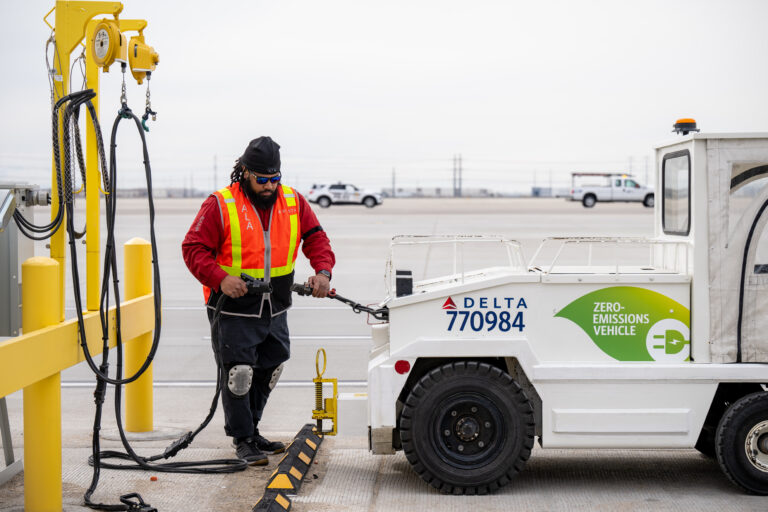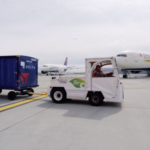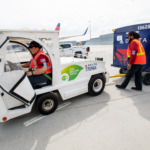
- Kim Kisner
- Business
- 12/05/2023
Challenges Include Technology, International Regulations

Delta Air Lines employs 95,000 people and operates 4,000 flights a day, flying to more than 280 destinations on six continents, and expects to serve nearly 200 million customers this year.
13.7 million passengers flew in or out of Detroit Metro Airport in 2022, making it Delta’s third-largest hub.
We interviewed Gail Grimmett, Delta’s senior vice president of sustainability performance and strategic partnerships, to learn more about the airline’s sustainability strategy.
Q: How does Delta approach sustainability?
A: We are on a journey to reach net zero by 2050, so we have milestones and smaller goals we are working toward for 2025, 2030, and 2035 to help us get to net zero. Our goals fall into two main pillars.
The first is to embed sustainability in everything we do. This allows us to concentrate on things we can control today and allows sustainability to penetrate the entire business.
The second is to eliminate our climate impact from flying. This is where our fuel and fleet come into play.
So, we focus on these two main pillars and have set key targets and goals for each.
 Q: What does your sustainability team look like and how is it organized within the company?
Q: What does your sustainability team look like and how is it organized within the company?
A: It’s set up to support the pillars. We have councils set up across the organization that work toward our goals. For example, we have a Carbon Council that is led by our chief of operations. This group is focused on innovation and fuel usage, looking for fuel efficiencies and savings
Last year we saved 10 million gallons in fuel by weight reduction and by flying in a more efficient manner such as altitude and speed.
We have sustainability embedded across the organization working on finding efficiencies and opportunities in areas we can control today.
Q: Is sustainability addressed any differently here?
A: All airports are different, but because we have great partners with the Airport Authority, we’re able to make changes outside of just our operation, like with LED lighting, low-flow water within the terminal, and within our catering kitchens. Since Detroit is a hub, it is a key airport for us that we look at regularly. We’ve been working on electrifying our ground service equipment (GSE) to convert to 100% electric by 2025 in five of our hubs and 100% in all of our hubs by 2035.
Q: What are your short-term sustainability goals?
A: In the short term, we are focusing on what we can control within our operation. For example, leveraging our councils to reduce fuel usage by another 10 million gallons this year. By 2035 we expect the Carbon Council to have saved 1.1 billion gallons of fuel, which is important from both a cost and emissions perspective.
We are eliminating single-use plastics from planes. We eliminated 4.9 million pounds of plastic from planes as of last year, and on Dec. 5, we announced a new paper cup that we are testing in-flight that once fully rolled out will eliminate another 7 million pounds of single-use plastic.
Changes like a new paper cup are no easy task. These cups must handle both hot and cold materials and meet international regulations that can vary from country to country. We’re a global airline, and, operationally, we can’t just stock every aircraft differently based on the countries they travel through. We have to satisfy the sustainability regulations of all countries on all planes.
Q: What about longer-term goals?
A: We need to be net zero by 2050. That is the goal everyone in the industry is racing toward. To accomplish this, we need to focus on large-scale changes – things like switching to sustainable aviation fuel and hydrogen to power aircraft and building the supporting infrastructure.
All this is still being researched and tested. When we think about our fleet – what we fly and how we fly – we are looking at what we can do in the medium term and the long term. For example, each new aircraft we add to our fleet generates around 25% fuel savings, so we are also updating our fleets to be more efficient.
Q: What else are you working on to get to net zero by 2050?
A: The number one lever we can pull to decarbonize our industry is sustainable aviation fuel (SAF). Currently, there is not enough of it, so we need to ramp up production of it. Today, there is only enough SAF to barely cover one day’s worth of flying for the entire industry.
The government and policymakers are important as the production of SAF scales because we need the right policies and incentives to increase production and build the infrastructure to support SAF.
While that may seem daunting, a positive is that SAF is an immediate solution – it can be added directly into planes right now. So, while there isn’t enough of it, it can be blended with current fuel, so we can start with 50% SAF and move to 80% and then 100% as the production ramps up.
Also, this first-generation SAF won’t be the last. It will continue to evolve. This is one of the most exciting times to be in this field as there is so much need here, and so much innovation happening.
Q: I read that you focus on building your fleet to have the longest, most sustainable life possible. Can you tell us more about that?
A: Circularity is important to us. We look at refreshing planes, regenerating materials, and recycling. We hold onto our fleet for a long time but continually look at how to be more efficient with the fleet. Adjustments are being made to certain planes to reduce drag, which helps them become more fuel-efficient. This goes back to controlling what we can control while continuing to refresh the fleet as we can.
Q: What are the biggest challenges overall?
A: There are two.
The first is the pace of technology advancement. It needs to speed up and I think it will.
And, right now, differences in global regulations are top of mind for me in my role. As a global airline, we need to adhere to the different regulations of the places we travel to. This can come in many forms from the amount of single-use plastic onboard like with a plastic fork to sustainable aviation fuel. We aim to adhere to the most stringent regulations, but we’re always working through operational complexities as well. It’s a balancing act and can at times prove to be challenging.
Q: What are the biggest opportunities?
A: The industry commitment to this. A rising tide lifts all boats. We love healthy competition when it comes to sustainability, especially since we all need to be trying different things and see what works. When one of us wins, it’s a huge step forward for all of us. The entire industry needs to work together, and when that happens, we all get better. The commitment is exceptional.
Q: Do you have any advice for businesses when it comes to addressing sustainability?
A: The best advice I can give is to keep a mindset of progress over perfection. Start with progress move toward perfection and let investment and innovation continue to happen. Work to “bump and pivot” faster so you can adjust as technology evolves. This is applicable across all businesses.
Be sure to subscribe to our newsletter for regular updates on sustainable business practices in and around Detroit.
Kim Kisner
- All
- Business
- Community
- Education
- Events

Floyd, founded in Detroit in 2013, is a furniture company focused on creating modular, long-lasting pieces designed to reduce waste and rethink traditional home furnishings. Known for its clean, adaptable designs and commitment to sustainability, Floyd has grown from a single product to a full line of beds, sofas, tables, and storage solutions—all centered around durability and ease of assembly. SBN Detroit interviewed co-founder Kyle Hoff about how...

ZF Group, a global technology company with its North American headquarters in Northville, specializes in systems for passenger cars, commercial vehicles, and industrial technology. With a focus on next-generation mobility, the company develops solutions that address electrification, automation, and digitalization while aiming to improve safety, efficiency, and sustainability in transportation. SBN Detroit interviewed Anuj Shah, Sustainability Lead, for the Americas, to explore the most pressing environmental challenges in...

The Chip Bag Project, based in Detroit, is a sustainability initiative that upcycles hard-to-recycle snack packaging — particularly chip bags — into insulated sleeping bags for individuals experiencing homelessness. Founded by Eradajere Oleita, the project addresses both environmental waste and housing insecurity by transforming materials like Mylar into practical, thermally efficient solutions. In June, Oleita was among Trelllis’s 30 Under 30, its annual recognition of the brightest young...







